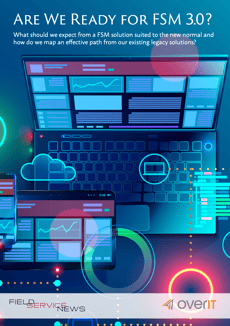Plotting a Path from Legacy Systems to 3.0
Dec 21, 2021 • Features • White Paper • OverIT • Covid-19 • Servitization and Advanced Services
In the last feature from a recent white paper we published in partnership with OverIT, we analyse the key aspects of migrating from a legacy system to a new FSM solution.

This feature is just one short excerpt from a recent white paper we published in partnership with OverIT.
www.fieldservicenews.com subscribers can read the full white paper now by hitting the button below.
If you are yet to subscribe you can do so for free by hitting the button and registering for our complimentary subscription tier FSN Standard on a dedicated page that provides you instant access to this white paper PLUS you will also be able to access our monthly selection of premium resources as soo as you are registered.

Data usage note: By accessing this content you consent to the contact details submitted when you registered as a subscriber to fieldservicenews.com to be shared withOverIT, sponsor of this premium content, who may contact you for legitimate business reasons to discuss the content of this white paper, as per the terms and conditions of your subscription agreement which you opted into in line with GDPR regulations and is an ongoing condition of subscription.
There are two key aspects of migrating from a legacy system to a new solution. The first is project planning for the migration itself. The second is to understand the human aspect of change- management as we seek to ensure quick adoption of the new tools from our end users.
In the concluding part of this paper, we shall take a look at each of these
PLANNING AND INTERATIVE DESIGN ARE KEY TO A SUCCESSFUL MIGRATION
As with all significant projects, it is essential to establish a strong, robust, and well-considered planning period.
This planning process should include identifying the key personnel within the planning team and outlining a project timeline. Given the mission-critical nature of field service delivery and the growing importance of service delivery to broader business strategies, wherever possible, it is worth considering making the critical appointments of those who will be most crucial to this project a full- time focus for the duration of the migration.
Moving from one system to another in any aspect of the business is challenging. In field service operations, a dedicated team focused solely on making the migration process seamless could be the difference between successful adoption and rapid evolution within your service organisation and catastrophe that could push progress back by years.
It is also important to have voices with different areas of expertise within that project team. Viewing such migration as an IT-only implementation is flawed. Leaders should view it as a business improvement initiative. Therefore, stakeholders from field service operations and IT, with their respective expertise, should be included within the core team, with relative subject matter experience to bring to the table. Experts also recommend seeking input from other relevant stakeholders, especially end-users such as field engineers and technicians.
However, perhaps the most critical voice in the process should be those who have been through this process before.
The solution provider you select to work with will have gone through this migration process with other clients and will know the pitfalls to avoid and the shortcuts to success. Throughout this entire process, they should be there to help guide you as you move from your legacy system to their next-gen solution, so lean on them for support as much as possible. It may even be that they can connect you to a trusted systems integrator that knows about taking companies from your existing system to your new system. While an additional cost, such insight and expertise can be invaluable and pay for itself within a short amount of time as you begin to see a return on your investment in these more sophisticated FSM tools.
One thing to consider is that the more traditional approach to implementation, where such projects can be active for at least six months before even taking the first actual steps to roll-out, is becoming less and less common. Increasingly, companies are adopting a more rapid approach of multiple small iterations, focusing on rapid development, issue resolution, and redevelopment as a solution moves from a minimum viable product to complete an adoption in incremental phases.
Systems integrators or solutions providers have the opportunity to utilize the knowledge of their existing environment, future environment, and transition practices. In this way, teams are not just recreating what existed previously into a new system, but they are simultaneously taking advantage of the new capabilities and new processes that the system offers.
Finally, as you begin to move through iterations and towards an actual go-live date, thinking about training and deployment becomes critical.
Training is also a crucial aspect of the change management process, which we shall look at in the concluding section of this paper.
CHANGE MANAGEMENT MUST BE FOCUSED ON PEOPLE ABOVE ALL ELSE IF IT IS TO SUCCEED
In any technology implementation, effective change management is critical. However, the stakes are even higher in this context, where the technology implementation can lead to significant new processes and even new service strategies.
Therefore, following a well-established path to managing the human aspect of change management is vital. Some key considerations include:
Understand the Task Ahead
Change is hard, and without a clear definition of your goals and the challenges you face, managing any change effectively can be at best a complicated and drawn-out process and, at worst, an abject failure.
In fact, according to change management guru John Kotter, 70% of change management efforts fail. This is mainly due to a lack of preparation, a lack of understanding of best practices, or a combination of both. However, at the heart of every successful change management exercise, one maxim holds. Change Management is always about people.
Engage Individuals in Their Heads and the Heart
For a change management program to succeed, we must acknowledge that change is about individuals, not organisations. Organisational needs and requirements will drive the change, but individuals will implement it and determine its success.
Given this notion, we must next consider how individuals will react to change. Successful change management is as much about feeling as it is about thinking. Change management is one of the fundamental principles in the Kotter Change Management philosophy and is widely accepted to be an essential step on the change management journey.
Embrace the Principles of Influence
Robert Cialdini’s six principles of influence are certainly also worth considering when planning your change management program.
The Six Principles include:
• Reciprocity
• Commitment and consistency
• Social Proof
• Liking
• Authority
• Scarcity
These key principles of influence are widely utilised in sales and marketing as they are fundamental pillars of communication that we universally understand as humans.
So as you begin engaging with your team around the changes you are introducing, a firm grounding in Cialdini’s principles can be a tremendous tool to have in your communications kit.
The Importance of the Change Agent
Building on the point above, by working with change agents, you will establish internal champions within the field workforce that can encourage widespread quick adoption amongst peers.
Gartner’s Elise Olding neatly sums up this approach stating, “Change resistance is a myth. Employees support enterprise goals when they understand what needs to be done. Change Agents put a face on change and leverage trusted informal leaders to create understanding among employees and influence organisational change.”
Breaking Down the Barriers of Resistance
The goal of a successful change management program should not be to eradicate resistance to change completely- this is an impossible task that will take too much energy.
Instead, focus on reducing the impact of resistance and overcoming it as quickly as possible to move the change management project from concept to full adoption as swiftly as possible.
The true key to successful change management is minimising the impact of resistance in your workforce- and to achieve this, we must understand the types of resistance we are likely to encounter.

This feature is just one short excerpt from a recent white paper we published in partnership with OverIT..
www.fieldservicenews.com subscribers can read the full white paper now by hitting the button below.
If you are yet to subscribe you can do so for free by hitting the button and registering for our complimentary subscription tier FSN Standard on a dedicated page that provides you instant access to this white paper PLUS you will also be able to access our monthly selection of premium resources as soo as you are registered.
 Data usage note: By accessing this content you consent to the contact details submitted when you registered as a subscriber to fieldservicenews.com to be shared with the listed sponsor of this premium content OverIT who may contact you for legitimate business reasons to discuss the content of this white paper, as per the terms and conditions of your subscription agreement which you opted into in line with GDPR regulations and is an ongoing condition of subscription.
Data usage note: By accessing this content you consent to the contact details submitted when you registered as a subscriber to fieldservicenews.com to be shared with the listed sponsor of this premium content OverIT who may contact you for legitimate business reasons to discuss the content of this white paper, as per the terms and conditions of your subscription agreement which you opted into in line with GDPR regulations and is an ongoing condition of subscription.
Further Reading:
- Read more about Servitization & Advanced Services @ www.fieldservicenews.com/servitization-and-advanced-services
- Read more about Digital Transformation @ www.fieldservicenews.com/digital-transformation
- Learn more about the impact of COVID-19 in the Field Service Industry @ www.fieldservicenews.com/covid-19
- Read more about OverIT on Field Service News @ www.fieldservicenews.com/exel
- Learn more about OverIT @ www.overit.it
- Follow OverIT on Twitter @ twitter.com/OverITSpA





















 Field Service News is published by 1927 Media Ltd, an independent publisher whose sole focus is on the field service sector. As such our entire resources are focused on helping drive the field service sector forwards and aiming to best serve our industry through honest, incisive and innovative media coverage of the global field service sector.
Field Service News is published by 1927 Media Ltd, an independent publisher whose sole focus is on the field service sector. As such our entire resources are focused on helping drive the field service sector forwards and aiming to best serve our industry through honest, incisive and innovative media coverage of the global field service sector.
Leave a Reply